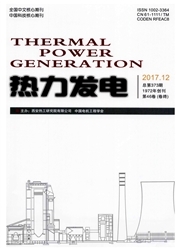

 中文摘要:
中文摘要:
阐述了节能、碳捕集、清洁能源替代3种较为普遍的碳减排技术发展现状,并分别选取一种代表性技术进行了减排性能和经济性能对比分析。结果表明:采用二次再热和700℃参数的新一代燃煤机组可通过提高效率减少能源消耗,降低CO2排放,但投资巨大;基于化学吸收法的后脱碳技术能够实现燃煤电厂的CO2大量减排,但会导致机组效率下降6~9百分点;不采用任何碳减排措施的天然气联合循环(NGCC)电厂碳排放量仅为燃煤电厂的45%左右,且其发电成本和碳减排成本在这3种技术中最低,在天然气价格增长幅度小于20%的范围内,NGCC电厂仍可呈现出良好的经济性能,可在近中期承担大量CO2减排任务。
 英文摘要:
英文摘要:
Three general carbon emission reduction technologies, namely energy saving, CO2 capture and storage (CCS), and nature gas replacement technology, are introduced and the development situation is presented. Moreover,three representative techniques are chosen to compare the mitigation performance and techno-economic performance. The results show that, the next generation coal-fired power plants with main steam temperature of 700℃ and double-reheat cycle can reduce the energy consumption by enhancing the net efficiency,thus to realize CO2 emission reduction, but the investment cost is huge. The post-CCS technique based on chemical absorption can reduce the CO2 emission sharply, but the unit efficiency decreases by 6~ 9 % points. Through clean energy replacement, the CO2 emission of nature gas combined cycle power plant without CO2 capture is only 45% of that in coal-fired power plant. Its cost of electricity (Cot) and the cost of CO2 avoided (CoA) is the lowest among these three techniques. In addition,with a certain extend in- crease of nature gas price (around 20 %), the nature gas combined cycle power plant still presents good economic performance. The results show the nature gas replacement is a potential technique aiming to achieve large mitigation in near and medium-term.
 同期刊论文项目
同期刊论文项目
 同项目期刊论文
同项目期刊论文
 期刊信息
期刊信息
